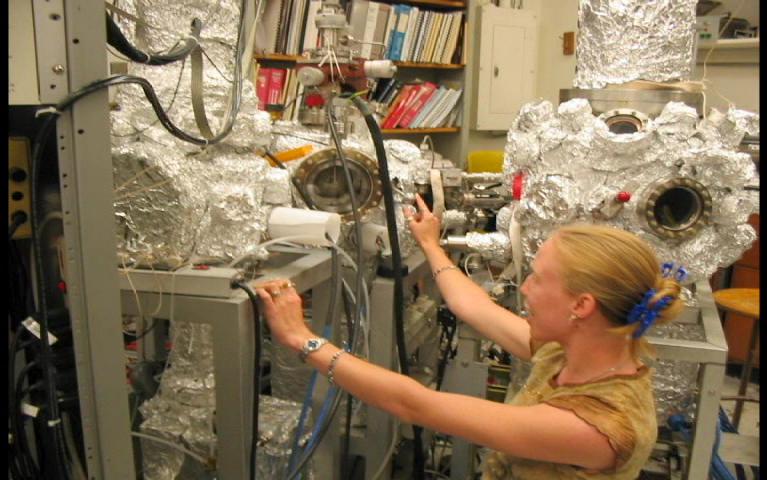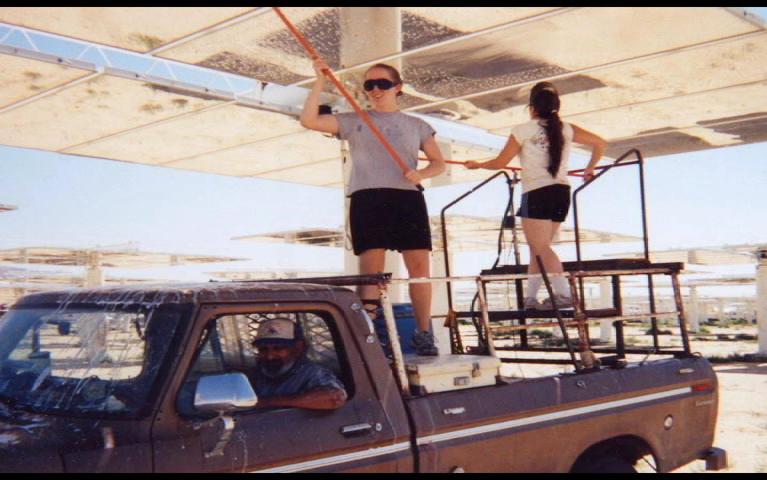
This REU program was funded through NSF PHY-0243904.


(Students' names link to their final papers. There are some formatting problems, particularly with figures, but you can still get a lot more detail about the projects from them.)
Condensed Matter Experiment
Dexter Nigos (Hartnell College; advisor Kai Liu) made arrays of Cobalt nanodots, 200-400nm diameter and 20-100nm thick, with pulsed electrodeposition. Hard disks store information in the magnetization, with each bit corresponding to a small region on the disk. Making bits physically smaller allows more storage space on a disk, and can improve disk speed as well. However, smaller bits need to exhibit significant hysteresis (memory) so that they hold a magnetization after the field that creates (writes) it is removed. Understanding the ways in which magnetic reversal occurs in small dots is important for incorporating smaller bits into hard drives. After preparing the samples, Dexter characterized both their geometry and magnetic properties. He found mainly single domain magnetism in the nanodots.
A scanning tunneling microscope (STM) can take atomic-scale images or metal surfaces. Examining the initial, intermediate, and final molecules during a chemical reaction will improve the molecular-level understanding of the process, for example by determining the binding sites for the different molecules. Stephanie Sears (Eastern Michigan University; advisor Shirley Chiang) worked on an early stage of an experiment to study benzene formation on a Palladium surface, using a silicon sample to calibrate the STM. With a different STM, Stephanie looked for domain periodicities in a Germanium sample. The measurements required cleaning the sample many times, a tricky procedure that can easily damage or melt it. The sample showed atomically flat terraces, but was destroyed not long after that. Further data await a new sample.
Nick apRoberts-Warren (Wheaton College; advisor Rena Zieve) assembled experimental cells consisting of a fine wire stretched inside a metal cylinder, terminating on a large bump. Theoretical work on defects on curved surfaces suggested that a superfluid helium vortex might pin to the edge of the bump rather than its center. Nick began by calculating what shape bump would best let us measure the effect, then spent several weeks learning to make, put together, and leak check the cell parts. Data acquisition from his two successful cells happened mere days after Nick left Davis. Measurements on vortex stability did provide evidence that the vortex terminated at the edge of the bump.
Patricia Voll (University of Washington; advisor Rena Zieve) also worked on superfluid helium vortices, using a fine wire to detect their motion. Patricia added a heating coil to a previously built setup. The original idea was that much of the interaction between a moving vortex and the wall of the container might be through small bits of other vortices stuck to the wall. If heating the cell walls could eliminate the vortex bits, subsequent vortex motion might have a markedly different character. Patricia began by measuring the thermal energy required to depin the primary vortex from the wire. These experiments revealed an unexpected history dependence to the depinning, which we spent the rest of the summer trying to understand. The measurements also proved useful as a sort of control for Nick's curvature experiment.
Victoria Winbow (Trinity University; advisor Rena Zieve) wrote code in IDL to select regions of a granular pile and measure the grain density within each region. Furthermore, since granular research requires good statistics, her program can identify analogous areas in a series of piles, and calculate the density for each. The project's goal was to build on last summer's observation of a correlation between the density of a pile and its angle immediately before an avalanche. Victoria worked on identifying which portions of a pile have densities correlated with stability; this will show which areas are most important for the pile's stability. As the sampled regions shrink, adequate data requires more avalanches. Future students will continue the work, beginning by acquiring more avalanche data.
Condensed Matter Theory
In the Blume-Capel Model, each site on a lattice is either occupied by a single spin or vacant; if a spin is present, it can be either up or down. Neighboring spins can interact, and a vacancy may carry an energy cost or savings. Nick Franciose (Mary Washington University; advisors Warren Pickett and Richard Scalettar) set up a nine-site calculation with the Blume-Capel Model in two dimensions. He generated results in two ways: by using the small size of his lattice to catalog its states completely, and by using a Monte Carlo algorithm to analyze the system's energetics from a smaller sampling of states. The Monte Carlo results agree well with the exact calculation, opening the way to increasing the size of the lattice, moving to three dimensions, or adding further complexity to the model itself.
Biological Physics
Danielle McDermott (Western Washington University; advisor Daniel Cox) learned to use the SIESTA density functional theory code. Her project began as environmental physics, but an interesting result in what was intended as a practice calculation led to a shift. In Danielle's calculation, iron ions bound more strongly than expected to a prion. If the high-binding affinity of iron persists as the simulation details are varied, it may be a clue to "mad cow" disease and other illnesses. Since misfolded prions and high metal concentrations are both present in diseased brains, there has been much recent interest in metal-prion interactions.
High Energy Experiment
Deriba Olana (Pacific Union College; advisor Mani Tripathi) did Monte Carlo simulations of events for the Compact Muon Solenoid (CMS) at the Large Hadron Collider (LHC). The LHC, a particle accelerator at CERN in Geneva, Switzerland, is slated to begin operating in 2007. CMS is one of several detectors at the collider, and the UC Davis particle group has been involved with CMS throughout its design and construction stages. CMS will measure about 1 billion events per second. In order to deal with such vast amounts of data, physicists need an accurate picture of what the Standard Model (the present theoretical understanding of particle physics) predicts and how new physics could appear. Deriba studied how technicolor interactions might generate a new particle, the techni-omega, and how the CMS would respond.
Sasha Laundy (Swarthmore College; advisor Mani Tripathi) worked on the C.A.C.T.U.S., a ground-based gamma ray telescope. She made two trips to Barstow to clean telescope mirrors and watch data acquisition in progress. The telescope seems to detect extra photons from the Draco galaxy. Draco has a large amount of dark matter, and a correlation between high-energy photons and dark matter would be an exciting result. Sasha investigated the background noise to make sure it was not causing the apparent signal from Draco, and calculated optimal threshold settings for taking further data.
Cosmology
In gravitational lensing, light bends as it passes by a heavy object on its way to an observer. Strong gravitational lensing leads to multiple images of a single object as well as distortion; each image is elongated. Weak lensing does not create multiple images but does cause distortion. It can make distant objects appear brighter than they would without lensing, allowing cosmologists to study more distant stars. Caralyn Flack (Bemidji State University; advisor Chris Fassnacht ) calibrated data from two radio interferometers, the Very Large Array and the Very Long Baseline Array, to identify precise locations and mass distributions of lensing galaxies.
Ken Wong (UC Davis; advisor Chris Fassnacht ) studied the spatial distribution of gravitational lenses: whether they are randomly distributed, or whether their location correlates to other mass. He calculated the total light observed in certain directions where the presence or absence of gravitational lenses is known, on the assumption that the total light correlates to the total mass. The analysis showed slightly more mass in the direction of the lenses, but the difference was so small that firm conclusions require more data.

